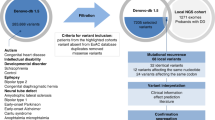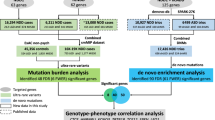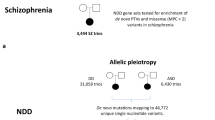Abstract
Epilepsy is a frequent feature of neurodevelopmental disorders (NDDs), but little is known about genetic differences between NDDs with and without epilepsy. We analyzed de novo variants (DNVs) in 6,753 parent–offspring trios ascertained to have different NDDs. In the subset of 1,942 individuals with NDDs with epilepsy, we identified 33 genes with a significant excess of DNVs, of which SNAP25 and GABRB2 had previously only limited evidence of disease association. Joint analysis of all individuals with NDDs also implicated CACNA1E as a novel disease-associated gene. Comparing NDDs with and without epilepsy, we found missense DNVs, DNVs in specific genes, age of recruitment, and severity of intellectual disability to be associated with epilepsy. We further demonstrate the extent to which our results affect current genetic testing as well as treatment, emphasizing the benefit of accurate genetic diagnosis in NDDs with epilepsy.
This is a preview of subscription content, access via your institution
Access options
Access Nature and 54 other Nature Portfolio journals
Get Nature+, our best-value online-access subscription
$29.99 / 30 days
cancel any time
Subscribe to this journal
Receive 12 print issues and online access
$209.00 per year
only $17.42 per issue
Buy this article
- Purchase on Springer Link
- Instant access to full article PDF
Prices may be subject to local taxes which are calculated during checkout


Similar content being viewed by others
References
McTague, A., Howell, K. B., Cross, J. H., Kurian, M. A. & Scheffer, I. E. The genetic landscape of the epileptic encephalopathies of infancy and childhood. Lancet Neurol. 15, 304–316 (2016).
Myers, C. T. & Mefford, H. C. Advancing epilepsy genetics in the genomic era. Genome Med. 7, 91 (2015).
Scheffer, I. E. et al. ILAE classification of the epilepsies: position paper of the ILAE commission for classification and terminology. Epilepsia 58, 512–521 (2017).
McGrother, C. W. et al. Epilepsy in adults with intellectual disabilities: prevalence, associations and service implications. Seizure 15, 376–386 (2006).
Thomas, S., Hovinga, M. E., Rai, D. & Lee, B. K. Brief report: prevalence of co-occurring epilepsy and autism spectrum disorder: the U.S. National Survey of Children’s Health 2011–2012. J. Autism Dev. Disord. 47, 224–229 (2017).
Robinson, E. B. et al. Autism spectrum disorder severity reflects the average contribution of de novo and familial influences. Proc. Natl. Acad. Sci. USA 111, 15161–15165 (2014).
Deciphering Developmental Disorders Study. Prevalence and architecture of de novo mutations in developmental disorders. Nature 542, 433–438 (2017).
Li, J. et al. Genes with de novo mutations are shared by four neuropsychiatric disorders discovered from NPdenovo database. Mol. Psychiatry 21, 290–297 (2016).
Berg, A. T. et al. Revised terminology and concepts for organization of seizures and epilepsies: report of the ILAE Commission on Classification and Terminology, 2005–2009. Epilepsia 51, 676–685 (2010).
Berg, A. T. & Millichap, J. J. The 2010 revised classification of seizures and epilepsy. Continuum (Minneap. Minn.) 19, 571–597 (2013).
Helbig, I. & Tayoun, A. A. Understanding genotypes and phenotypes in epileptic encephalopathies. Mol. Syndromol. 7, 172–181 (2016).
Trump, N. et al. Improving diagnosis and broadening the phenotypes in early-onset seizure and severe developmental delay disorders through gene panel analysis. J. Med. Genet. 53, 310–317 (2016).
Depienne, C. et al. Spectrum of SCN1A gene mutations associated with Dravet syndrome: analysis of 333 patients. J. Med. Genet. 46, 183–191 (2009).
Weckhuysen, S. et al. Extending the KCNQ2 encephalopathy spectrum: clinical and neuroimaging findings in 17 patients. Neurology 81, 1697–1703 (2013).
Wolff, M. et al. Genetic and phenotypic heterogeneity suggest therapeutic implications in SCN2A-related disorders. Brain 140, 1316–1336 (2017).
Stamberger, H. et al. STXBP1 encephalopathy: a neurodevelopmental disorder including epilepsy. Neurology 86, 954–962 (2016).
Howell, K. B., Harvey, A. S. & Archer, J. S. Epileptic encephalopathy: use and misuse of a clinically and conceptually important concept. Epilepsia 57, 343–347 (2016).
Chambers, C., Jansen, L. A. & Dhamija, R. Review of commercially available epilepsy genetic panels. J. Genet. Couns. 25, 213–217 (2016).
Lemke, J. R. et al. Targeted next generation sequencing as a diagnostic tool in epileptic disorders. Epilepsia 53, 1387–1398 (2012).
Iossifov, I. et al. The contribution of de novo coding mutations to autism spectrum disorder. Nature 515, 216–221 (2014).
Zaidi, S. et al. De novo mutations in histone-modifying genes in congenital heart disease. Nature 498, 220–223 (2013).
Singh, T. et al. The contribution of rare variants to risk of schizophrenia in individuals with and without intellectual disability. Nat. Genet. 49, 1167–1173 (2017).
Lelieveld, S. H. et al. Meta-analysis of 2,104 trios provides support for 10 new genes for intellectual disability. Nat. Neurosci. 19, 1194–1196 (2016).
EuroEPINOMICS-RES Consortium. Epilepsy Phenome/Genome Project & Epi4K Consortium. De novo mutations in synaptic transmission genes including DNM1 cause epileptic encephalopathies. Am. J. Hum. Genet. 95, 360–370 (2014).
Hamdan, F. F. et al. De novo mutations in moderate or severe intellectual disability. PLoS Genet. 10, e1004772 (2014).
de Ligt, J. et al. Diagnostic exome sequencing in persons with severe intellectual disability. N. Engl. J. Med. 367, 1921–1929 (2012).
Rauch, A. et al. Range of genetic mutations associated with severe non-syndromic sporadic intellectual disability: an exome sequencing study. Lancet 380, 1674–1682 (2012).
Helbig, K. L. et al. Diagnostic exome sequencing provides a molecular diagnosis for a significant proportion of patients with epilepsy. Genet. Med. 18, 898–905 (2016).
Fischbach, G. D. & Lord, C. The Simons Simplex Collection: a resource for identification of autism genetic risk factors. Neuron 68, 192–195 (2010).
Samocha, K. E. et al. A framework for the interpretation of de novo mutation in human disease. Nat. Genet. 46, 944–950 (2014).
Lek, M. et al. Analysis of protein-coding genetic variation in 60,706 humans. Nature 536, 285–291 (2016).
Kosmicki, J. A. et al. Refining the role of de novo protein-truncating variants in neurodevelopmental disorders by using population reference samples. Nat. Genet. 49, 504–510 (2017).
Reimand, J. et al. g:Profiler-a web server for functional interpretation of gene lists (2016 update). Nucleic Acids Res. 44, W83–W89 (2016).
OCEBM Levels of Evidence Working Group. The Oxford Levels of Evidence (Oxford Centre for Evidence-Based Medicine, Oxford, 2009).
Richards, S. et al. Standards and guidelines for the interpretation of sequence variants: a joint consensus recommendation of the American College of Medical Genetics and Genomics and the Association for Molecular Pathology. Genet. Med. 17, 405–424 (2015).
Mulley, J. C., Scheffer, I. E., Petrou, S. & Berkovic, S. F. Channelopathies as a genetic cause of epilepsy. Curr. Opin. Neurol. 16, 171–176 (2003).
Rehm, H. L. et al. ClinGen: the Clinical Genome Resource. N. Engl. J. Med. 372, 2235–2242 (2015).
Weckhuysen, S. et al. KCNQ2 encephalopathy: emerging phenotype of a neonatal epileptic encephalopathy. Ann. Neurol. 71, 15–25 (2012).
Wagnon, J. L. et al. Pathogenic mechanism of recurrent mutations of SCN8A in epileptic encephalopathy. Ann. Clin. Transl. Neurol. 3, 114–123 (2015).
Blanchard, M. G. et al. De novo gain-of-function and loss-of-function mutations of SCN8A in patients with intellectual disabilities and epilepsy. J. Med. Genet. 52, 330–337 (2015).
Wilkie, A. O. The molecular basis of genetic dominance. J. Med. Genet. 31, 89–98 (1994).
Haynes, W. A., Tomczak, A. & Khatri, P. Gene annotation bias impedes biomedical research. Sci. Rep. 8, 1362 (2018).
MacArthur, D. G. et al. Guidelines for investigating causality of sequence variants in human disease. Nature 508, 469–476 (2014).
Millichap, J. J. et al. KCNQ2 encephalopathy: features, mutational hot spots, and ezogabine treatment of 11 patients. Neurol. Genet. 2, e96 (2016).
De Giorgis, V. & Veggiotti, P. GLUT1 deficiency syndrome 2013: current state of the art. Seizure 22, 803–811 (2013).
Farwell, K. D. et al. Enhanced utility of family-centered diagnostic exome sequencing with inheritance model-based analysis: results from 500 unselected families with undiagnosed genetic conditions. Genet. Med. 17, 578–586 (2015).
Huppke, P. et al. Activating de novo mutations in NFE2L2 encoding NRF2 cause a multisystem disorder. Nat. Commun. 8, 818 (2017).
Trujillano, D. et al. Clinical exome sequencing: results from 2819 samples reflecting 1000 families. Eur. J. Hum. Genet. 25, 176–182 (2017).
Chilamakuri, C. S. et al. Performance comparison of four exome capture systems for deep sequencing. BMC Genomics 15, 449 (2014).
Ware, J. S., Samocha, K. E., Homsy, J. & Daly, M. J. Interpreting de novo variation in human disease using denovolyzeR. Curr. Protoc. Hum. Genet. 87, 7.25 (2015).
Rubinstein, W. S. et al. The NIH genetic testing registry: a new, centralized database of genetic tests to enable access to comprehensive information and improve transparency. Nucleic Acids Res. 41, D925–D935 (2013).
Acknowledgements
We thank all patients and their families who participated in this study, as well as the teams who were involved in recruiting patients and gathering samples and data at the respective study sites. We thank L. Vissers and C. Gilissen for epilepsy and age phenotypes from the cohort of Lelieveld et al.23 and J. McRae for useful discussions on the DDD cohort7. We are grateful to members of the ATGU and the Institute for Human Genetics in Leipzig for insightful discussions. We thank J. Krause for support in figure design and helpful conversations. This work was supported by the Eurocores program EuroEPINOMICS, the Fund for Scientific Research Flanders (FWO), International Coordination Action (ICA) grant G0E8614N, and the University of Antwerp (research fund). H.O.H. was supported by stipends from the Federal Ministry of Education and Research (BMBF), Germany, FKZ: 01EO1501 and the German Research Foundation (DFG): HE7987/1-1. H.S. was supported as a PhD fellow of the Fund for Scientific Research Flanders (1125416 N). I.H. and Y.G.W. were supported by DFG grants WE4896/3-1 and HE5415/6-1. R.G. received funding through the EU Seventh Framework Programme (FP7) under the project DESIRE grant N602531. The DDD study presents independent research commissioned by the Health Innovation Challenge Fund (grant HICF-1009-003), a parallel funding partnership between the Wellcome Trust and the Department of Health, and the Wellcome Trust Sanger Institute (grant WT098051). The views expressed in this publication are those of the authors and not necessarily those of the Wellcome Trust or the Department of Health. The research team acknowledges the support of the National Institute for Health Research, through the Comprehensive Clinical Research Network.
Author information
Authors and Affiliations
Consortia
Contributions
H.O.H. performed the analyses and drafted the manuscript. H.O.H. and J.R.L. conceived the study. H.O.H., J.R.L., M.J.D., T.S., D.L. and H.S. contributed to analysis concepts and methods. H.O.H., J.R.L., D.L., I.H., T.S., M.J.D., S.M.S., and S. Weckhuysen interpreted the results. T.S., H.S., R.A.J., H.C., D.C., P.D.J., R.G., K.L.H., B.P.C.K., J.A.K., D.L., T.L., P.M., H.M., R.S.M., B.A.N., A. Palotie, M.P., P.S., S.T., S. Wu, the EuroEPINOMICS RES Consortium, S.T., A. Poduri, Y.G.W., S. Weckhuysen, and I.H. provided patient data or analysis tools. All authors revised and approved the final manuscript.
Corresponding authors
Ethics declarations
Competing interests
The authors declare no competing interests.
Additional information
Publisher’s note: Springer Nature remains neutral with regard to jurisdictional claims in published maps and institutional affiliations.
Supplementary information
Supplementary Figures
Supplementary Figures 1–10 and Supplementary Note
Supplementary Table 1
Description of cohorts analyzed in this study
Supplementary Table 2
List of all DNVmis, DNVtrunc, and DNVsynonymous of all NDD cohorts (n = 6,753) and controls (n = 1,911) analyzed in this study
Supplementary Table 3
List of 50 dominant and X-linked known EE genes
Supplementary Table 4
Genes with at least two DNVmis+trunc in NDDEE+uE (n = 1,942)
Supplementary Table 5
Genes with at least two DNVmis+trunc in all NDD (NDD EE+uE +woE, n = 6,753)
Supplementary Table 6
Significantly enriched HPO terms in 33 genes with DNV burden in NDD with epilepsy
Supplementary Table 7
Evaluating genes with at least two DNVmis+trunc in NDD with epilepsy for therapeutic consequences
Supplementary Table 8
Gene sets significantly enriched (odds raio > 1) or depleted (odds ratio < 1) for DNV in epilepsy compared to no epilepsy
Supplementary Table 9
DNV in epilepsy vs. no epilepsy
Supplementary Table 10
DNV in NDDuE vs. NDDEE
Supplementary Table 11
Diagnostic sequencing panels from 24 different academic and commercial providers
Supplementary Table 12
191 dominant/X-linked genes in sequencing panels from 24 different academic/commercial providers with three criteria for disease association in NDD with epilepsy (DNV burden, constraint, brain expression)
Supplementary Table 13
Evaluating 50 genes lacking features of DNV-enriched genes (DNV enrichment, constraint, brain expression) for published evidence for disease association using guidelines from the ClinGen Gene Curation Workgroup
Rights and permissions
About this article
Cite this article
Heyne, H.O., Singh, T., Stamberger, H. et al. De novo variants in neurodevelopmental disorders with epilepsy. Nat Genet 50, 1048–1053 (2018). https://doi.org/10.1038/s41588-018-0143-7
Received:
Accepted:
Published:
Issue Date:
DOI: https://doi.org/10.1038/s41588-018-0143-7
This article is cited by
-
The spectrum of neurological presentation in individuals affected by TBL1XR1 gene defects
Orphanet Journal of Rare Diseases (2024)
-
De novo variants in GABRA4 are associated with a neurological phenotype including developmental delay, behavioral abnormalities and epilepsy
European Journal of Human Genetics (2024)
-
Epilepsy-linked kinase CDKL5 phosphorylates voltage-gated calcium channel Cav2.3, altering inactivation kinetics and neuronal excitability
Nature Communications (2023)
-
Assembloid CRISPR screens reveal impact of disease genes in human neurodevelopment
Nature (2023)
-
Integrated exome and transcriptome analysis prioritizes MAP4K4 de novo frameshift variants in autism spectrum disorder as a novel disease–gene association
Human Genetics (2023)



